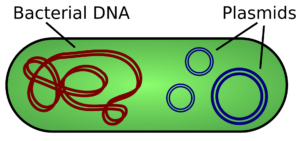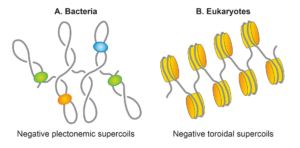Like most living organisms prokaryotes have DNA in their cytoplasm.
Prokaryotes or bacteria are so named because they do not have a proper nucleus. Instead, they have a single chromosome winded in a circular fashion called the nucleoid. There is also some circular DNA fragments found out of the nucleoid as well.
As to the question do prokaryotes have dna in the cytoplasm, yes they do in the nucleoid as well as in plasmids. Plasmids are extra DNA fragments that do not have any genetic information stored in them.
Plasmids have rather different functions especially in the case of developing specific genes for survival. They are of great importance, especially in parasitic or pathogenic bacteria. Plasmids are also of great biological importance and have led to the making of recombinant biotechnology techniques.
What is found in the cytoplasm of prokaryotes?
Bacterial cytoplasm is a gel matrix with no membrane-bound organelles.
Unlike eukaryotes, prokaryotic cells do not contain what is called a nucleus, or various membrane-bound organelles. They contain the basics that are required for a living organism to survive.
The cytoplasm is composed of mainly water(80%), nutrients, enzymes, wastes, inorganics ions and some cell structures like ribosomes and DNA. The ribosomes are required for protein synthesis. The genetic form of circular double-stranded DNA existing as a single chromosome is found in the nucleoid. This unlike the nucleus does not have any membrane covering it.

Image: Wikipedia
More circular DNA fragments can be found in the cytoplasm in the form of plastids. Since there is no skeletal structure to a bacterial cell all the components of the cell are scattered across the cytoplasm. The only exception is the nucleoid that remains in the central part of the cell.

Image: Wikipedia
Why is DNA located in the cytoplasm of prokaryotes?
Prokaryotes do not have a designated nucleus to hold the genetic material so it is found in the cytoplasm instead.
Prokaryotes or bacteria are considered to be primitive organisms. They do not possess what is called a true “karyon” or” nucleus”. Hence the genetic material just randomly exists in the cytoplasm.
Instead of the nucleus, bacteria have what is called a nucleoid. This is nothing but the naked double-stranded DNA bound by NPAs sitting tight in the central part of the cell. So the DNA is technically located in the cytoplasm.

Image: Wikipedia
Without a membrane-bound structure, it is easy for the genetic material to move through the jelly-like cytoplasm.
Is prokaryotic DNA scattered in the whole cytoplasm?
Plasmid DNA in bacterial cells is scattered across the cell cytoplasm.
Technically only plasmid DNA is scattered across the bacterial. The chromosomal DNA lives in the central part as the nucleoid.
Since bacterial cells do not have a nuclear membrane to contain the genetic material, it is just embedded in the central part of the cell cytoplasm. The single chromosome is made of one double-stranded circular DNA which makes the shape more stable.
But bacterial cells also have a few more circular DNA fragments scattered across the cytoplasm. They do not contain any genetic material. Rather they synthesize specific genes that can be used in unfavourable conditions by the prokaryote.
Do prokaryotic cells have DNA free in the cytoplasm?
Plasmids can be considered as free-floating DNA in the prokaryotic cytoplasm.
The nucleoid or nucleus like structure is also free-floating in nature. But it is mainly plasmids that are free circular DNA fragments that are considered as free-floating in the cytoplasm.
Since prokaryotes do not have any membrane-covered organisms, all the DNA is in reality present in the cytoplasm without any barriers. There is no separation of spaces or areas in the cytoplasm.

Image: Wikipedia
The nucleoid is called a pseudo nucleus because there is no nuclear membrane surrounding it. The DNA is coiled and stabilized by Nucleosome Assembly Proteins or NAPs. NAPs are the only reason the nucleoid DNA doesn’t unfurl and float about in the cytoplasm.
What is the cytoplasm’s function?
Cytoplasm or protoplasm of bacterial cells is mainly a matrix that holds all the components together.
Made of 80% water and also gases, organic and inorganic components is what gives shape and volume to the cell.
Bacterial cytoplasm is the same nearly the same in matrix composition as that in eukaryotes. The main difference is the absence of any membrane-bound organelles except ribosomes that are essential for protein synthesis.
Since bacteria are devoid of most organelles most of their functions can be performed by the bacterial cytoplasm.
Functions of cytoplasm:
- Contain all the materials including the DNA and ribosome.
- It stores gases, food particles and waster particles.
- It allows for the exchange of gases.
- They also store excess materials required for cytokinesis or cell division.
Plasmid DNA and its uses:
- Plasmid DNA are the small circular DNA fragments found in bacterial cells
- They are separate from genetic DNA and have no such function.
- Plasmid DNA can independently synthesize various genes that can be used by bacteria in unfavourable conditions.
- These include synthesizing antibiotic-resistant or drought and temperature resistant genes. The ability of bacteria that can survive in the most uninhabitable conditions on the planet factors its success to plasmids.
- These plasmids are of great scientific importance as well. Scientists use these plasmids to extract and cline them for medicinal, commercial or agricultural uses.
- Antibiotic-resistant genes are used to test newer ranges of antibiotics before being introduced into the market.
- These genes can also be used in agricultural fields. Using recombinant biotechnology scientists have introduced pest and drought-resistant crops.
One of the most commonly heard examples is the Bt brinjal, a genetically engineered variety of brinjal or aubergine or eggplant. They were produced by taking a specific protein from a bacterial called Bacillus thuringenesis and putting the gene responsible in a plasmid. Then after cloning the plasmid they added the plasmid to the plant cell.
The protein synthesized by this gene- Cryl Ac is poisonous only to pests that feast on the brinjal plants and is considered harmless to humans. This technique saved farmers from a loss due to pest infestations and also on pesticides.
FAQ: Why is bacterial DNA unique?
The presence of extrachromosomal DNA is a feature unique to bacteria or prokaryotes.
Apart from chromosomal DNA bacterial cytoplasm is also scattered with non-chromosomal DNA or plasmid DNA. These plasmids are responsible for producing very specific genes that are conditionally used.
Plasmids DNA does not contain any genetic information in it.
Also Read:

I am Trisha Dey, a postgraduate in Bioinformatics. I pursued my graduate degree in Biochemistry. I love reading .I also have a passion for learning new languages.
Let’s connect through linked in: